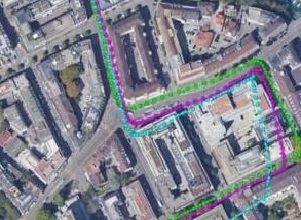ORBCOMM on deploying an M2M solution for telematics industry-Satellite OR Cellular
“While there will always be different providers of communications services, in order for M2M to become more ubiquitous, more convergence of platforms will be required. Moore’s Law will do its job in terms of advancing technology and lowering costs, but creating an “Internet of Things” will require more standardization.”
Craig Montgomery, Sr. Vice President-Marketing, ORBCOMM
Satellite and cellular machine-to-machine (M2M) platforms have come a long way in the past 10 years.

In 2004, satellite was considered the best — and perhaps only — option to track drivers and assets across the country and international borders. The coverage was reliable, but satellite constellations had cost billions to launch into space. The price for usage was steep. Fleets therefore had to limit transmissions by size, duration and frequency to manage expenses. Cellular platforms offered a more affordable alternative, but fleets were still hesitant to trade these cost savings for seamless coverage.
A decade ago, mainstream cellular was 2G with 3G starting to percolate. Phones with Bluetooth were considered “cutting edge” but the actual phone numbers were not portable and 1MB data plans with pooling were not affordable. The dual-mode platform was merely a concept for having the best of both worlds — speed when you have it and coverage when you need it most. Meanwhile, GPS processors were sucking power from tracking devices like an F5 tornado. Solar power with its large, fragile and ineffective panels did not appear likely to be powering tiny tracking devices in a harsh mobile environment anytime soon.
The in-cab industry was largely dominated by one satellite M2M provider and trailer tracking providers were few and far between. Mobile software applications were clunky with difficult-to-learn functions and macros for communications. Reporting was limited and the deployment costs of M2M solutions were significant.
Combined, these factors created an advantage for large fleets with greater resources to stay current with technology while small and medium haulers tended to economize and deploy just enough to get by such as Nextel “direct connect” radios.
Fast forward to 2014
Any discussion of M2M today goes beyond one-to-one connectivity between vehicles, drivers and the office via cellular and satellite networks. M2M is now synonymous with the “Internet of Things” as vehicles are inundated with devices and sensors.
Mainstream cellular is now 3G with 4G coming on strong as discussions of 5G are taking place. Data plans are affordable and dual-mode platforms fill any gaps in coverage. Next generation satellites are now being deployed with massive increases in power and bandwidth and beam coverage all without commanding a premium difference in price. Tracking devices have become compact, ruggedized and maintenance free with the advent of solar-powered, rechargeable batteries. All the while, the amount of data that can be streamed between trucks and the office is stunning.
In short, the capabilities and options for deploying technology have multiplied by tenfold, if not more. You can track, locate, navigate and monitor anything on wheels using any device with an Internet connection. Fleet managers can even change the temperature settings of refrigerated trailers or lock and unlock trailer doors from a smart phone, for example, or better yet, have their computer systems do it automatically based on the pre-set parameters dictated by the items listed in the bill of lading.
As technology adoption has increased, what once was considered cutting edge, too expensive and impractical to deploy is now mainstream. Small haulers are able to provide the same type of reports and data to their clients as larger competitors. The transportation industry has become just as good, if not better, at delivering information than delivering freight.
Why is this important?
According to a recent Georgia Tech study, supply chain glitches can torpedo shareholder value. After adjusting for industry and market movements, the total shareholder value loss associated with a glitch can be as high as 25 percent.
To put this into perspective, consider the cost to deliver a box of cereal. According to the Council of Supply Chain Management Professionals, the total logistics costs to deliver a $3.60 box of cereal from the field to the consumer’s table is about $0.37 with a net retail profit of about $0.05.
Knowing where that box of cereal is and ensuring it gets there on time is the difference between $.05 and $.03 cents per box. According to statisticsbrain.com, 2.7 billion boxes of cereal are sold a year in the U.S. The $0.02 spread is now $54 million in lost profit for retailers.
Driving adoption
Of all the problems that technological advances in M2M have solved during the past 10 years, they have raised many questions. For instance, why is the market not adopting technology faster? Why have sensors not become more diverse with deeper local area communication between devices? Why hasn’t RFID exploded across the scene of the supply chain in every crate and pallet being moved?
The answer to these and other questions is a lack of a standard communications platform. The reason why the Web exploded so quickly after Tim Berners-Lee invented it was because it was based on a standard HTTP platform. Cellular has CDMA and GSM, for example. Wireless protocols include Wi-Fi, Bluetooth and Zigbee. RFID consists of active and passive tags.
While there will always be different providers of communications services, in order for M2M to become more ubiquitous, more convergence of platforms will be required. Moore’s Law will do its job in terms of advancing technology and lowering costs, but creating an “Internet of Things” will require more standardization.
Where we go from here?
One way to indirectly drive standardization within the primary M2M communications platforms (satellite and cellular) is by creating a Multi-network Access Point Platform (MAPP). Simply put, this is a platform that seamlessly translates and integrates the communications from a diverse network of service partners into a uniform set of commands and information.
This would facilitate a uniform platform for provisioning, billing and multi-mode access for M2M applications, enabling access to network and terminal management tools for integration. The MAPP concept could be coupled with standard modems that have the same footprint, connectors, power input and programming environment.
A platform such as this eliminates the worry about VHS versus L-Band satellite communications, or GSM versus CDMA cellular communications. Manufacturers and partners would simply be able to drop in the appropriate modem corresponding with the optimal network based on geography, message size and delivery speed for unrivaled ease of use and flexibility.
On the other hand, standardizing the various local-area communications protocols such as Wi-Fi, Bluetooth and Zigbee will primarily be driven by market forces. These technologies all have pros and cons, but there are two key aspects that will win in the transportation and distribution sector.
- Power consumption. In transportation and logistics, devices are often forced to operate without power when decoupling the tractor from the trailer or the container from the chassis.
- Mesh network. As we evolve from tracking containers and trailers to pallets and boxes, a mesh network is the next logical step in total transparency of goods from manufacturing to the customer door or store floor. It’s also the key to creating a robust “Internet of Things” where trucks talk to trucks, boxes talk to boxes, boxes talk to trailers, etc.
According to a study by management consulting firm Bain & Company, companies that employ sophisticated supply chain methods enjoy 12 times greater profit than companies with unsophisticated methods.
The future is now. Much, if not all, of the technology that is needed to create this degree of sophistication is here but deploying it should not be complicated. Unlocking its value can only be done by deploying solutions to determine what is optimal for your fleet and customers. As you begin to test different solutions, you will begin to understand which satellite and cellular networks are optimal for your fleet’s behaviors and which devices can provide the tracking, locating and monitoring technology demanded for your operations.
Put another way, can you really afford not to deploy new M2M communications and tracking technology?
About the author
Craig Montgomery is ORBCOMM’s Senior Vice President of Marketing, where he leads the company’s product management, marketing, branding and public relations team for its global M2M business. He has over 18 years of experience in wireless communications and high-tech products with a heavy focus on vertical applications such as transportation & distribution. He was also Sprint Nextel’s head of Direct Marketing for all business units as well as the Director of Marketing for the transportation, distribution and manufacturing verticals at Nextel prior to the merger. In addition, Mr. Montgomery served as the Chief Operating Officer and Senior Vice President of Marketing for Seneca One Finance and held other senior marketing roles with CoStar Group and Dell. He holds an MBA from Vanderbilt University and a Bachelor of Science from San Diego State University.
This article was originally featured in Smart Automotive May-June edition. To read the latest edition of Smart Automotive, please click here.



